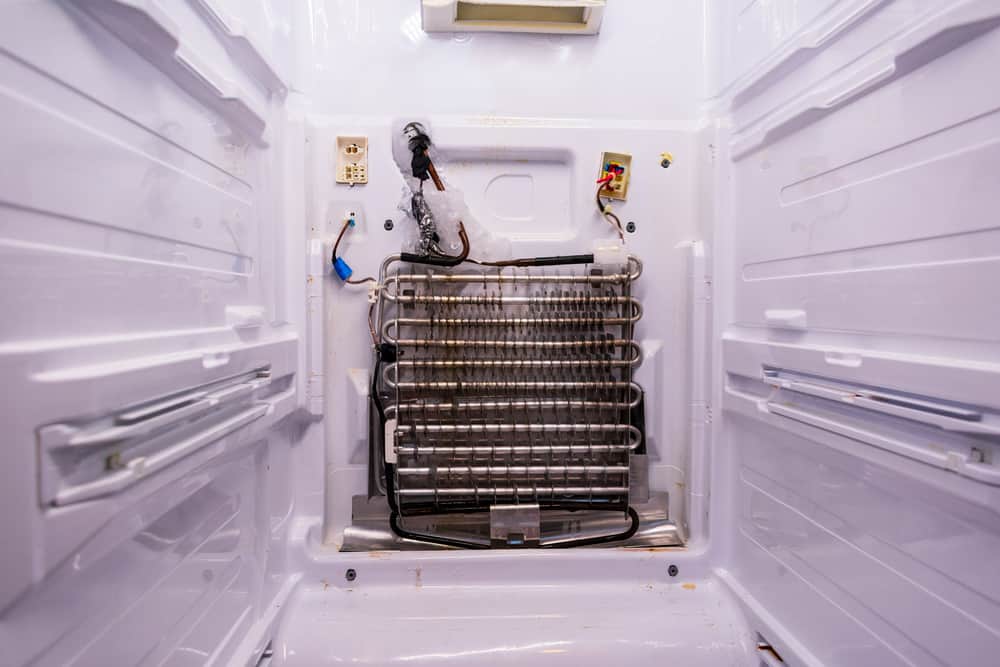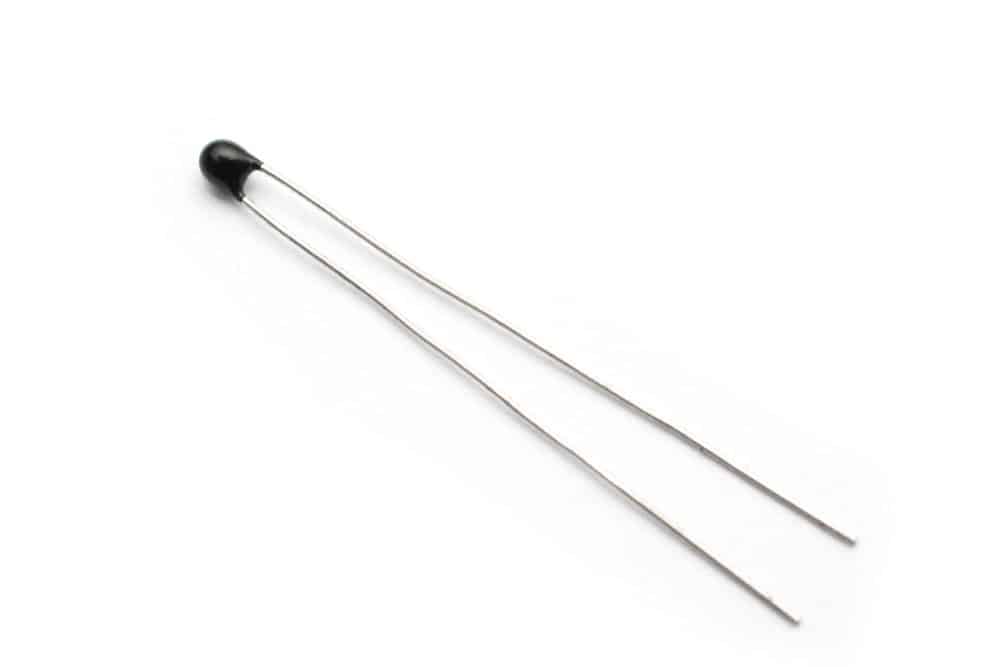It might seem like a simple device, but what is a freezer sensor and how does it work? A freezer sensor device is crucial to the efficiency of your freezer and refrigerator and monitoring temperature.
The freezer sensor checks the temperature of the freezer. If the temperature rises, the sensor communicates with the control panel to troubleshoot the issue. It can also prevent the freezer from getting too cold and seizing up.
Understanding the purpose of a freezer sensor will help you identify when yours is working correctly or when you should replace it. You can always call a professional to help, but you’ll learn everything you need to know in this article.

Frozen Evaporator Coils in the Freezer Compartment of a Fridge-Freezer
Find out things about a freezer sensor, such as:
A freezer sensor, or thermistor, is a way to check the temperature of your freezer. It takes a reading of the freezer temperature and sends it to the control board. If it needs to be cooler or warmer, the sensor can change it, so your food stays frozen.
You might need a new freezer sensor if you notice problems like:
It might seem strange that your freezer sensor can also impact the fridge, but this temperature sensor can monitor the entire appliance. The refrigerator and freezer use the same energy, so the thermistor can help regulate both parts of this unit.

A thermistor regulates the temperature of your freezer
A thermistor is what keeps the freezer within a few degrees for safe food storage. When the temperature rises in the freezer, the thermistor senses this temperature change and turns on the cooling cycle.
The thermistor timer turns on the appliance’s heating coil every six hours. These coils warm up just enough to melt the ice off of it. If it’s not working properly, the ice will make the coils frost over. The freezer will struggle to remain at the right temperature and can cause your food to spoil.
If the refrigerator thermistor isn’t working properly, it can cause damage to your freezer and refrigerator. Once you get to the point of severe damage, you’ll need to call for extensive repairs. In some cases, you’ll need a total replacement.
If your thermistor isn’t working, your freezer will waste energy trying to stay at the right temperature. But without a freezer thermometer in action, it will work too hard or not enough to keep your food frozen. You’ll waste energy and have to throw away the ruined food.
Manufacturers use thermistors in more than just freezers. It’s also used in fire alarms to detect changes in the room temperature and alert people about smoke or rapid heat changes. Ovens, toasters, and microwaves use thermistors to regulate heat distribution. Air conditioning units, digital thermometers, and automobiles also use thermistors for temperature regulation.
A Z-Wave freezer sensor has a temperature probe that you can keep in a freezer to regulate temperature while the rest of the sensor stays outside. The remote sensor lets you know the temperature of the freezer’s interior without opening the door. The probe connects with a thin wire that doesn’t impact the seal of the freezer door, keeping the temperature balanced inside.
You can use battery-powered freezer sensors, but the alkaline batteries will deplete quickly at such cold temperatures. Using Z-Wave instead lets you protect the control panel and have it in a central location. The probes are all you need to put in the freezer to ensure it stays at an ideal temperature.
The probes send the temperature to the control panel, so you should keep them relatively close. If you want to use the Z-Wave hub in another room entirely, you might find that the signal weakens. That could make the difference between you noticing a problem in your freezer temperature or still thinking everything is fine.
If you don’t want to use Z-Wave, you can use other remote temperature options. Many manufacturers are developing temperature strips that don’t need batteries and can still send signals to your control panel. Thanks to technological advances, there are even models that you can link with your Google Home or Amazon Alexa.
Z-Wave temperature sensors are also helpful in other appliances like a GE refrigerator, a wine cooler, and even your swimming pool. Anything that needs to stay at a steady temperature can benefit from a temperature sensor. With Z-Wave technology, you’ll get a freezer alarm on your phone or smart home device if the temperature drops drastically.
The defrost sensor is slightly different from the refrigerator thermostat. The refrigerator thermostat is the temperature gauge that cools the fridge. It measures the temperature inside the refrigerator to keep it from overheating or freezing up. Extreme temperatures make the thermostat tell the compressor to turn on or off to prevent damage.
The defrost temperature sensor is on the bottom or back of a refrigerator. It’s near the defrost system coils but has a wire harness making it easy to remove and replace. The thermostat has mercury like a standard thermometer, though the lowest reading is 0 degrees Fahrenheit.
Some newer defrost temperature sensors don’t use mercury and wires. Instead, they plug directly into the refrigerator and detect more than just temperature. They can also tell when there’s a problem with the compressor, heater, or thermostat.
The defrost temperature sensor waits until the freezer reaches a certain point and activates the heating element based on those variables. The defrost temperature sensor works according to these factors:
The defrost temperature sensor turns on at specific time intervals, and it will do this regardless of frost level, with the intent of keeping the heating element clear.
It measures the evaporator’s temperature but only turns on once the evaporator reaches a specific cold temperature. At this point, it starts to warm up and defrost the evaporator to keep it functioning.
An infrared sensor on the defrost thermostat measures the frost. It can build up in small increments, so the heating elements activate when it hits a specific thickness, and the heating element melts away the accumulated frost.
Defrost thermostats are crucial for freezers and refrigerators because they work with the freezer sensor to prevent build-up.
Freezer sensors might sound like outdated technology; however, it’s essential to know how well your freezer sensor works. Instead of checking on it often, you can use a smart freezer sensor.
Refrigerators and freezers have thick insulation to keep the food safe to eat, so you might wonder how an outside signal can permeate the doors. When you place the sensor inside the freezer, you’ll need a wireless hub very close by. The signals from inside the freezer won’t be too strong, so you should decrease the distance as much as possible.
Bluetooth is the best option for smart freezer sensors because it’s more efficient than WiFi. You can find plenty of battery-powered sensors with Bluetooth connections. When you bring your phone near the freezer, you’ll get an alert about the temperature status.
If you have a smart refrigerator, you already have access to the appliance’s data through your phone. Some smart fridges have their own apps with freezer sensor data and controls. But not every fridge has the same features, so you can always get a separate smart freezer sensor for your fridge, whether it’s smart or basic.
You can test your freezer sensor by looking at the temperature reading. Even if the thermistor isn’t working properly, it will most likely still show a reading. It will still show the ideal reading in many cases, so you won’t think anything is wrong. You can use a separate infrared thermometer to get an accurate reading of the freezer and fridge temperatures.
In some drawers lower in the fridge, it might still be cool enough for the food to stay safe. Since you probably noticed the temperature difference in the fridge or freezer, it’s likely anywhere from 40 to 60 degrees.
The Food and Drug Administration recommends you throw away certain foods if they’re stored at 40 degrees Fahrenheit for two or more hours. It’s hard to waste food, but make sure you’re keeping your family safe by checking the temperature and making a good choice about what food to keep. It’s easy to get sick from spoiled food.
When you can feel the change in temperature, you have an idea that the problem is the freezer sensor. But you should still check and see if the fan is still running. If it’s not, you can replace everything at once. The fan can often still work fine even with a bad temperature sensor, so it’s best to troubleshoot both areas before diagnosing the problem.
If you’ve ever replaced washer parts or dishwasher parts, changing a temperature sensor is just as easy. Check your owner’s manual to ensure you’re getting the right part. You want to stick with whatever brand the manufacturer says fits with the appliance.
The first step is cutting the power to the fridge. You can unplug it or shut off the fridge at the circuit breaker. Then find the thermistor. Your owner’s manual might show you the exact location. It’s usually on the back or side of the refrigerator.
There will be several screws holding the thermistor cover in place. Depending on the freezer temperature, the screws might freeze over. You can use a hairdryer to melt the ice so you can unscrew them.
Mounting clips hold the thermistor in place, so it’s not hard to unclip them, unplug the wire, and take out the thermistor. You can use the same mounting clips and harness for your new thermistor, so just click it into place. Screw the cover back into place and reconnect the fridge to the power.
Depending on what temperature the fridge and freezer’s interiors reached, it could take up to 12 hours for the appliance to cool back down to 40 degrees. This temperature is what the FDA deems food-safe, so you don’t want to eat any food above that temperature for two hours, and you also shouldn’t put new food in the fridge until it reaches that temperature.
